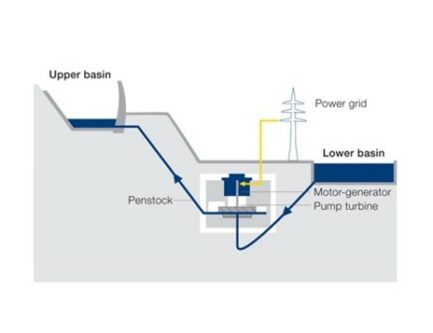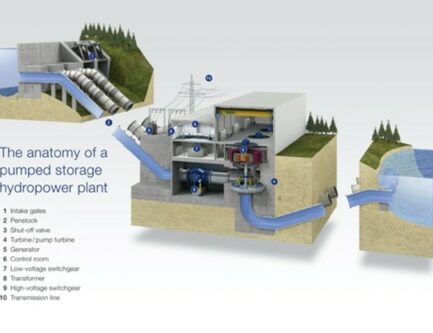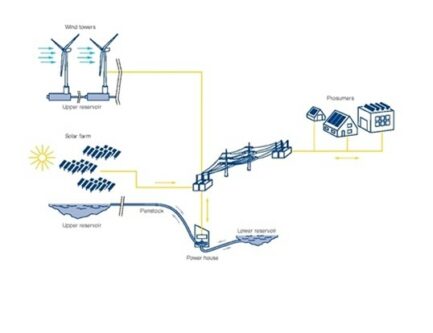Pumped Storage Hydropower plants store potential energy by pumping water to a higher elevation (charging) and releasing it (discharging) through generating turbines to create electricity on demand. Pumped Storage Hydro is the oldest and most widely deployed energy storage technology. The first facility was built in Switzerland in 1908. It is operating today. Beginning in 1930, more than 40 pumped storage plants have been constructed across the United States. The fleet provides more than 90% of the nation’s energy storage, typically designed to supply around eight hours of energy at a time.
Today’s consumers and utility regulators demand that low-cost wind and solar energy play an ever-increasing role in our electrical system. Energy storage allows for this clean, but intermittent power, to be available when it is needed. Short-term chemical batteries, for instance, store daytime solar energy for use in the evening, but experts agree that only long duration energy storage (more than four hours) can provide the reliable, at-the-ready resources that soon-to-be-replaced coal and natural gas currently offer.
Rather than just discharging stored energy, like a chemical battery, Pumped Storage Hydropower mimics the good attributes of traditional large generators.
CCEW repurposes Pumped Storage Hydropower with functionality that surpasses conventional or even adjustable speed PSH. First, the overall facility is designed as a Trybrid© power station, designed to use on-and off-site wind and solar energy to power its pumps. Second, owing to its ternary design and hydraulic short-circuit hydro-turbines, CCEW can respond to any energy service the grid operator or load center requires. Third, its Large Volume, Long Duration (“LVLD”) energy storage is designed to charge or discharge instantaneously or even simultaneously. To envision this unusual flexibility, without additional charging, the LVLD system can deliver energy at its maximum hourly capacity of 720 MW, for 5 days (121 continuous hours), or at reduced capacities, but still sufficient to power 90,000 households for 30 days. Unlike batteries, CCEW delivers without concern for the number of cycles over its lifespan, whereas Lithium-ion at 100,000 lifetime cycles and approximately 15 years of service degrades continuously. Moreover, CCEW performs in a time-tested way at any level without degradation, attrition, or obsolescence for a century of service.
CCEW meets that new demand through hydro-turbine innovation, superior electronics and cyber-security for power modulation and reaction times, all coupled to the impressive Upper Reservoir volume of 100,000 acre-feet, CCEW employs 6–120 MW Voith ternary hydro-turbines, designed and deployed specifically for the capabilities demanded of this Project. The 100,000-acre-foot storage Upper Reservoir with 840 acre-feet of hydrostatic head drives these ternary-design turbines and creates the first of its kind large volume, longest duration energy new storage facility in the nation.
Contemporary industry research is now just catching up to CCEW’s design choices. The National Renewable Energy Lab reports ternary PSH technology is “a valuable and robust tool for maintaining the reliability and resiliency of the grid as well as integrating increasingly higher penetrations of renewables on to the transmission system.”
Here is the challenge: every climate model for the Pacific Northwest, and southwestern Idaho in particular, predicts increasingly warmer temperatures over the next 50 years, even if global warming can be limited to 1.5 degrees centigrade. As a result, there will be less snowpack (the largest water storage system in the Northwest). Combined with more frequent winter rains, it will melt earlier, the growing season as a result will be lengthened a month on average by the warmer weather, and there will be less irrigation water available later in the season without significant new retention. Paradoxically, the annual average amount of precipitation is forecast to grow around 9% (that’s the projection for the Upper Boise River Basin) so earlier releases that currently cannot be captured, along with harmful earlier seasonal flooding, will become more and more probable. We’ve seen such flooding occur over the past five years in Idaho, Oregon, and Washington. The obvious way out of this paradox is to store excess run-off in the Spring, and in the process, mitigate flood damage, and release water later in the Summer when it is much needed for irrigation. CCEW has already signed Memorandums of Understanding (MOU) with forward-looking irrigation districts and municipalities downstream from the Project.
As an Off-Stream PSH, Anderson Ranch Reservoir, would serve as the lower reservoir for the pumped-storage facility eliminating the cost and impacts of building a second reservoir. Water used to fill the Upper Reservoir would come from the CCEW water right appropriating otherwise unallocated South Fork Boise River excess run-off. Cat Creek Reservoir water released for beneficial downstream use is subject to replacement to meet energy storage requirements under terms to be negotiated in the Bureau of Reclamation (“USBR”) Lease of Power Privilege (“LOPP”) between CCEW and USBR.
In the Pre-application Document (PAD) recently filed with the Federal Energy Regulatory Commission guiding the rigorous NEPA environmental evaluation process that precedes the issuance of a FERC Hydropower License and the USBR LOPP, there is a comprehensive 53-page discussion of potential CCEW impacts, both beneficial and harmful. It surveys the basic ecology of the Project area, identifies the ecological parameters which may need further study, and develops ways in which any potential impacts on key species (in particular sage-grouse and bull trout) can be avoided or best be mitigated. The context for the discussion of potential environmental impacts can be described briefly (the PAD contains much more detail):
- The developers of the Project, members of the John Faulkner family, have lived and worked in this area for generations. They want to keep using most of the ranchland on which it is located for livestock grazing and preserve open space.
- The members of the Project management team have for decades been engaged in environmental protection. CCEW is the culmination of their efforts to deal with both a main cause (carbon-emissions) and a main effect (decreasing natural water storage) of climate change harmful to the land and the people, plants, and animals on it.
- The many consultants hired by CCEW are experts in the areas of water quality, wildlife habitat and forage, aquatic, and avian species most at stake with a project of this kind. They will continue to collaborate with experts in the same areas from the USBR and the Idaho Department of Fish and Game (“IDFG”) to establish the base-line data, forecast the impacts, and establish avoidance and where necessary mitigation strategies. Similar collaboration is being pursued with natural resource experts from the four tribes for whom this area has traditionally been home ground.
- To deal with unanticipated impacts, a CCEW created Stakeholders Advisory Board of interested and informed local citizens, as well as agency and tribal representatives is being formed. It will be funded by CCEW to monitor environmental impacts as they arise and mitigate them in the most effective ways possible.





